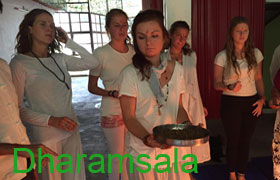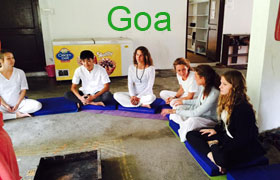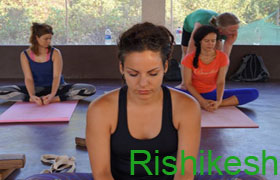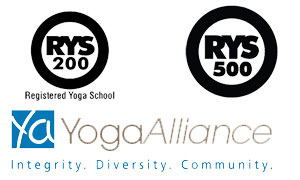Tolangulasana
Procedure
1. Sit down in the posture of padmasana.
2. Close both of your fists and place them behind your hips.
3. Balancing your body, raise your knees upwards and slowly lean your body backwards.
4. While reverting to the original state place your knees on the ground and remove your fists from behind your hips.
Benefits
1. Helpful in diabetes and haemorrhoids.
2. Highly beneficial for constipation and digestive system.
3. Influences adrenal glands.
Precautions
This asana should not be practiced if you have undergone any surgery in stomach or if you suffer with back ache or knee pain or chronic constipation.
Eka Padangushtasana
Procedure
1. Place your right ankle under your hips and fold your left leg and place it over your right thigh.
2. Maintain balance on your toes taking the help of your hands.
3. Slowly raise your hands and bring them into the position of namaskara.
4. Pause in this state for a while keep your breath constant.
5. Repeat the same procedure with the other leg too.
Benefits
1. Strength, wisdom, vitality and speed of the body are improved through the practice of this asana.
2. Very helpful in case of Haemorrhoids.
3. This asana can strengthen the muscles of your legs.
Precautions
You should not practice this asana if you experience giddiness or if you experience pain in your knees.
Our Yoga teacher training in Rishikesh is headed by certified yoga expert to train you with all these asanas.
Sheersha Asana
This asana is practiced based on the strength of your head. Also this asana is the best among all the asanas. Thus it is called the sheersha asana.
Procedure
1. Sit down in the posture of vajrasana and spread your knees.
2. Clasp the fingers of both of your hands while keeping some distant between your hands. Now place them on the basket.
3. Place the middle part of your head in the middle of your palms and place the upper part of the palate over the ground.
4. Now straighten your legs and raise them up gradually.
5. Balance your body over your head and gradually raise your body completely up.
6. Pause in this posture as long as you can and then fold your legs backwards and gradually drop your knees and legs on to the ground.
7. Place your head on your feet for a while. Do not raise your head immediately.
Precautions
1. You should use a blanket to practice sheershasana.
2. Take the help of wall in the initial state.
3. You should not place the middle part of your head on the ground. Instead you should place the upper part of the palate over the ground. Else you might get hurt.
4. You should not practice sheershasana if you suffer with high blood pressure, ear infection or heart problem.
5. You should keep your eyes open while practicing this asana. Otherwise your eyes might become weak.
6. Sheershasana should not be practiced when you suffer with migraine or head ache.
7. You can avail all the benefits of sheershasana with the practice of sarvanga asana too. Moreover sarvanga asana can be practiced by everyone and it has no negative effects.
Benefits
1. It improves the blood circulation to the brain. Consequently it improves the memory.
2. It turns the grey hair to black. It is efficient in controlling the hair fall.
3. It is capable of clearing foreign elements and bacteria from your lungs.
4. It can highly influence the pituitary and pineal glands. Consequently it improves concentration, memory and grasping power of an individual.
Our yoga teacher training in Dharmasala is the best source learn this asanas.
Padma Sheershasana
Procedure
1. Get into the posture sheershasana.
2. Gradually fold each leg at once similar to padmasana.
3. Pause for a while in this posture and then unfold your legs and revert to sheershasana. Now slowly drop your legs on to the floor.
Benefits and Precautions
Same as that of sheershasana.




